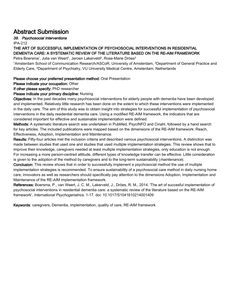Presentatie gegeven over de review in Brussel Objectives: In the past decades many psychosocial interventions for elderly people with dementia have been developed and implemented. Relatively little research has been done on the extent to which these interventions were implemented in the daily care. The aim of this study was to obtain insight into strategies for successful implementation of psychosocial interventions in the daily residential dementia care. Using a modified RE-AIM framework, the indicators that are considered important for effective and sustainable implementation were defined.
MULTIFILE

Background: Although principles of the health promoting school (HPS) approach are followed worldwide, differences between countries in the implementation are reported. The aim of the current study was (1) to examine the implementation of the HPS approach in European countries in terms of different implementation indicators, that is, percentage of schools implementing the HPS approach, implementation of core components, and positioning on so‐called HPS‐related spectra, (2) to explore patterns of consistency between the implementation indicators across countries, and (3) to examine perceived barriers and facilitators to the implementation of the HPS approach across countries. Methods: This study analyzed data from a survey that was part of the Schools for Health in Europe network's Monitoring Task 2020. The survey was completed by HPS representatives of 24 network member countries. Results: Large variations exist in (the influencing factors for) the implementation of the HPS approach in European countries. Observed patterns show that countries with higher percentages of schools implementing the HPS approach also score higher on the implementation of the core components and, in terms of spectra, more toward implementing multiple HPS core components, add‐in strategies, action‐oriented research and national‐level driven dissemination. In each country a unique mix of barriers and facilitators was observed. Conclusion: Countries committed to implementing the HPS approach in as many schools as possible also seem to pay attention to the quality of implementation. For a complete and accurate measurement of implementation, the use of multiple implementation indicators is desirable.
DOCUMENT

From the article: "After 1993, the concept of strategic alignment is evaluated from the connection between IT and business to much broader definitions in which the connection between all business functions, horizontally and vertically, and later also with projects and stakeholders is mentioned. To achieve stategic alignment there must be a coordination between the strategy of organizations and those who contribute to the implementation of the strategy and the actual performance of an organization. This process is called Human Oriented Performance Management (HOPM). The HOPM model consists of four dimensions: strategy translation, information and visualization, dialogue and action orientation, and continues improvement and organizational learning. To measure the effect of strategic alignment a range of financial performance indicators are used. Based on a literature review this paper explores which financial performance indicators could be used to measure the effect of HOPM. The literature was selected over a period from 1996 – 2015. The research is not only focused on the top of the strategy map, but also on the cause-effect relationships in the strategy map. The underlying performance indicators in the strategy map can show on which figures the dialogue in the HOPM model about strategy implementation must be based. This dialogue is the input to action in which strategic alignment comes about. The goal of the research is to optimize this dialogue by looking for performance indicators that can show the effect of HOPM" The article is used for the course: 'corporate policy' minor MSMM (Masterclass Strategic Marketing Management).
DOCUMENT
